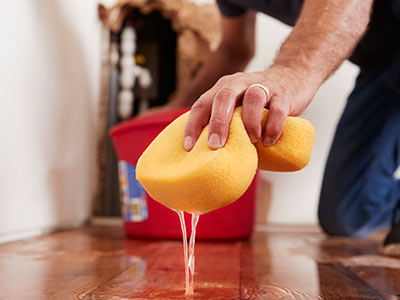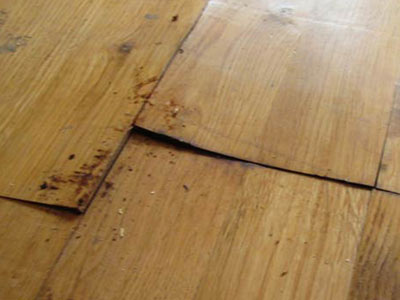Back to Maintenance & Care
Water-Damaged Hardwood Floors: Should You Repair or Replace Them?
 Noticed your hardwood floor starting to swell, warp, or balloon? Chances are, excessive moisture is the culprit. This type of water damage to wood floors is a common problem for many homeowners and can cause serious structural and visual issues if left untreated.
Noticed your hardwood floor starting to swell, warp, or balloon? Chances are, excessive moisture is the culprit. This type of water damage to wood floors is a common problem for many homeowners and can cause serious structural and visual issues if left untreated.
Superficial water damage—like light stains or minor surface marks—can often be fixed with simple cleaning or refinishing. But when water penetrates deeper, problems like cupping, warping, and swelling in hardwood floors appear, and the decision becomes trickier: should you repair water-damaged wood floors, or is full replacement the smarter choice?
In this guide, we’ll explore how water impacts wooden flooring, the signs of minor vs. severe damage, and the key factors to consider when deciding whether repair or replacement is the best solution for your home.
How Does Hardwood Flooring React to Increased Moisture Levels?
Wood is a natural, porous material. This means your hardwood floors will always respond to changes in humidity and moisture levels. When indoor air becomes more humid, floorboards expand; when the air dries out, they contract. In small amounts, this movement is harmless and the floor usually returns to its original state. However, prolonged or excessive exposure to moisture can trigger more serious problems.
Common Issues Caused by Moisture in Hardwood Floors
- Cupping and Bulging: High moisture can make boards swell unevenly, creating raised edges or bulging centres. This not only affects the floor’s smooth finish but can also weaken its structural stability and, in extreme cases, cause breakage.
- Gaps Between Floorboards: When wood expands and contracts too frequently, visible gaps may form. These reduce the insulation and sturdiness of the floor, while also making it look worn and uneven.
Surface vs. Subfloor Moisture Damage
The severity and type of hardwood floor moisture damage often depend on where the water comes from:
- Subfloor Moisture: If water rises from beneath (due to leaks, damp subfloors, or poor insulation), boards can swell into a convex shape—arching in the middle and even lifting in severe cases.
- Surface Moisture: When spills, leaks, or cleaning water penetrate from above, boards often become concave, creating a “bowl effect” with edges curling upwards.
Recognising these signs early is crucial. By understanding how wood reacts to moisture, you can take preventive steps like timely repairs, proper sealing, and consistent humidity control. These measures will help you preserve both the beauty and the structural integrity of your hardwood floors.
Common Causes of Water Damage to Hardwood Floors
Water is the number one enemy of wood, and when it sneaks into your flooring, it can cause swelling, warping, stains, and long-term structural problems. Understanding the main causes of water damage to hardwood floors is key to preventing costly repairs later. Here are the most common culprits:
- Inappropriate Cleaning Methods: Using too much water when mopping or choosing harsh cleaners can let moisture seep into the boards. This often leads to swelling, warping, and discolouration. Always stick to cleaning products designed for hardwood floors and use a slightly damp, not soaking wet, mop.
- Improper Installation Practices: If the subfloor (often concrete) isn’t properly dried, sealed, or moisture-tested before installation, water can migrate upward, compromising the stability of the boards. Correct preparation and professional hardwood floor installation help avoid this hidden risk.
- Spills and Accidents: Everyday mishaps—spilled drinks, pet water bowls, or overwatering houseplants—are some of the fastest ways to create immediate water damage to wood floors. Quick action is critical: wipe spills immediately with a dry cloth or use a wet vacuum for larger messes.
- High Humidity Environments: Consistently high humidity makes wood absorb excess moisture. Over time, this causes cupping, buckling, or gaps between boards. To prevent this, maintain indoor humidity between 35%–55% and ensure good ventilation year-round.
- Roof Leaks and Appliance Failures: Hidden sources like roof leaks, burst pipes, or malfunctioning washing machines can release large amounts of water, causing severe and widespread damage. Regular inspections of plumbing, roofing, and appliances can save your floors (and your budget) from disaster.
Some causes, like spills and leaks, are obvious. Others, like moisture trapped beneath wood flooring, are harder to spot until damage becomes visible. That’s why regular inspections, proactive maintenance, and quick responses to warning signs are vital to prevent water damage to hardwood floors and extend their lifespan.
Water and Moisture Damage – What to Do Now?
 When water or moisture finds its way onto your hardwood floor, speed is everything. The longer water sits, the more likely it is to seep deeper into the boards, causing swelling, warping, and even mould growth. Whether it’s a small spill or a more serious leak, here’s how to respond effectively:
When water or moisture finds its way onto your hardwood floor, speed is everything. The longer water sits, the more likely it is to seep deeper into the boards, causing swelling, warping, and even mould growth. Whether it’s a small spill or a more serious leak, here’s how to respond effectively:
- Act Immediately: Blot up spills or standing water right away using a dry, absorbent cloth. Quick action can stop moisture from penetrating the wood fibres.
- Prevent Permanent Damage: Fast cleanup reduces the risk of permanent stains, warping, and mold formation.
- Call in the Experts: For severe cases, contact professional water-damaged wood floor repair specialists. They can properly assess the damage and recommend repair or replacement.
- Spot Repairs: If only a small area is affected, hardwood spot repair may be possible, saving both money and disruption compared to replacing the entire floor.
- Assess the Extent: A flooring professional can evaluate whether repair is sufficient or if full replacement is needed, based on how deep and widespread the damage is.
Dealing with Surface-Level Water Damage
Superficial water damage that only affects the finish or surface of the floor can often be managed at home. Here’s what to do:
- Wipe Immediately: Mop up water as soon as you notice it—don’t give it time to soak in.
- Dry the Surface: Use fans to circulate air and dry the boards faster. Ensuring the surface dries completely helps prevent moisture from sinking deeper.
- Use a Dehumidifier if Needed: If water has been sitting for hours, run a dehumidifier to reduce excess moisture in the room and speed up the drying process.
- Get a Professional Check-Up: Even after cleanup, it’s wise to have a wood floor specialist inspect your floors to confirm there’s no hidden damage.
By responding quickly and effectively, you can often save water-damaged hardwood floors before the problem spreads. For more serious or long-term water exposure, however, professional restoration or even replacement may be necessary.
Repair vs. Replace: How to Decide
Once water has damaged your hardwood flooring, the big question is: should you repair it or replace it altogether? The answer depends on the extent of the water damage, the age of your floor, and the overall condition of the boards. Here’s a quick guide to help you decide:
| When to Repair |
When to Replace |
- Minor surface-level stains or light discolouration
- Small areas of cupping or warping
- Localised damage (e.g. one corner or a few boards)
- Floor is relatively new and still structurally sound
- Spot repairs or sanding and refinishing can restore the look |
- Severe water damage covering large areas
- Boards that are buckled, lifted, or structurally weakened
- Mould growth beneath or between floorboards
- Damage coming from the subfloor (not just the surface)
- The floor is very old or has been repaired multiple times already |
In many cases, repairing water-damaged hardwood floors is possible if the problem is caught early and confined to a small area. Sanding, refinishing, and replacing a few boards may be enough. But if the water damage is widespread, affects the subfloor, or compromises the structure, replacing hardwood after water damage is usually the safer and more cost-effective option in the long run.
Unsure which option applies to you? A professional hardwood floor restoration specialist can assess the damage and recommend the most practical solution for your home.
Conclusion: Repair or Replace Your Water-Damaged Floor?
Water damage is one of the biggest threats to hardwood flooring, but it doesn’t always mean your floor is beyond saving. If the damage is minor and localised, repairs such as sanding, refinishing, or replacing a few boards can restore both the look and strength of your floor. However, if the damage is severe, widespread, or affects the subfloor, replacement is often the only long-term solution. Acting quickly and consulting a professional will give you the best chance of saving your investment and avoiding further complications.
To prevent future issues, maintain proper humidity levels, clean up spills immediately, and schedule regular floor inspections. A proactive approach ensures your hardwood floor remains beautiful, durable, and safe for many years.
FAQ: Water-Damaged Hardwood Floors
Can water-damaged hardwood floors be repaired?
Yes, if the damage is minor. Small stains, light cupping, or a few warped boards can often be repaired through sanding, refinishing, or spot board replacement.
When should I replace a water-damaged floor?
If the boards are severely buckled, mould has developed, or the damage has spread across large areas—including the subfloor—replacement is usually the best solution.
How much does it cost to repair vs. replace water-damaged hardwood floors?
Repair costs vary depending on the size of the affected area, but they are generally lower than replacement. Replacement, however, may be more cost-effective in the long term if the damage is extensive.
How do I dry water-damaged hardwood floors?
Wipe up surface water immediately, use fans to speed up drying, and run a dehumidifier to remove excess moisture from the air. For serious water exposure, call a professional to avoid hidden damage.
How can I prevent future water damage to wood floors?
Maintain indoor humidity between 35%–55%, clean spills promptly, avoid excessive water during cleaning, and regularly check appliances, plumbing, and roofing for leaks.